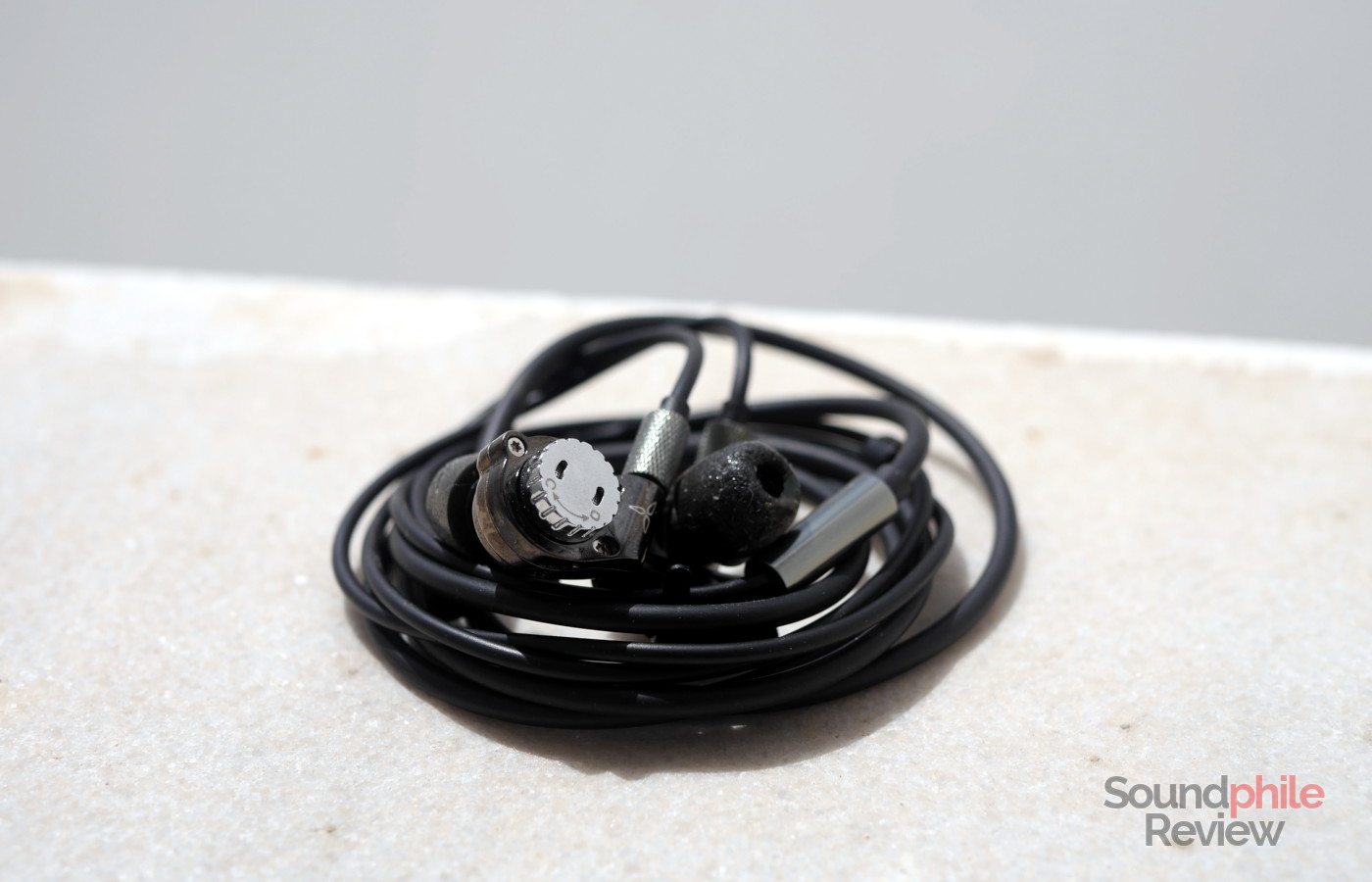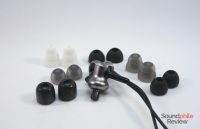The IMR Acoustics R1 are the current flagship (and only product) of this newcomer from UK which aims to impress its audience with advanced features and an accurate, pleasant sound that is on the verge of neutrality and boasts impressive technical prowess.
The IMR Acoustics R1’s most prominent feature is its modularity: its cable is detachable, a vast array of acoustic filters allows one to modify the sound signature and a gear on the housings switches from open to closed back and viceversa. It is almost endlessly customisable, giving the user a large degree of freedom in shaping their ideal listening experience.
Disclaimer: IMR Acoustics sent me a unit asking for a review. I won’t have to send it back. You can learn more on their website.
TL;DR: recap
| Pros |
Cons |
| Great build quality
Detachable cable Filter system + closed/open back selector Neutral(ish) tuning with a touch of brightness |
Comfort could be better
Semi-proprietary 2-pin connector Very low isolation, even in closed-back mode |
Rating: 9.5/10
Packaging & Accessories
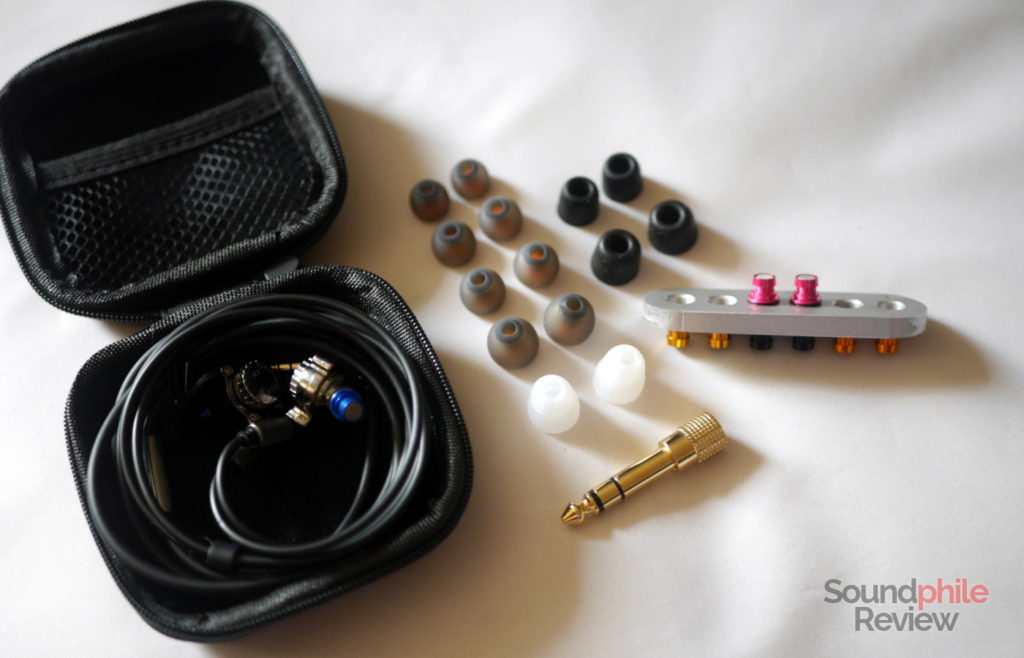
The IMR Acoustics R1 comes with a rich set of accessories: the box includes four pairs of silicone eartips (three single-flanged and two double-flanged), two pairs of foam eartips, a hard carrying case, a cable clip and a 3.5 mm to 6.3 mm jack adapter. On top of this, there are also five pairs of acoustic filters that can be installed on the housings; they are stored on a metal tray.
Considering the price range these are in, the accessories seem to be adequate. An improvement to this set would be the inclusion of a balanced cable (e.g. 2.5 mm), as it is increasingly common for DAPs and other equipment to offer balanced outputs. Additional eartips and a tray to store them would also be welcome – something like what’s included in the RHA CL1 Ceramic‘s box.
The only criticism I’d like to make regards the metal tray. It is rather large and has room for 12 filters: as only 10 filters are provided and 2 are supposed to always be mounted on the earphones, then 8 filters will be left to be stored on the tray – why the extra four places? On top of this, the tray I received is not as smooth as it should be, having coarse edges. These are not really flaws, but additional attention to these small details would improve the high-end feeling of the R1. My proposal is to make the tray square!
Design & Comfort
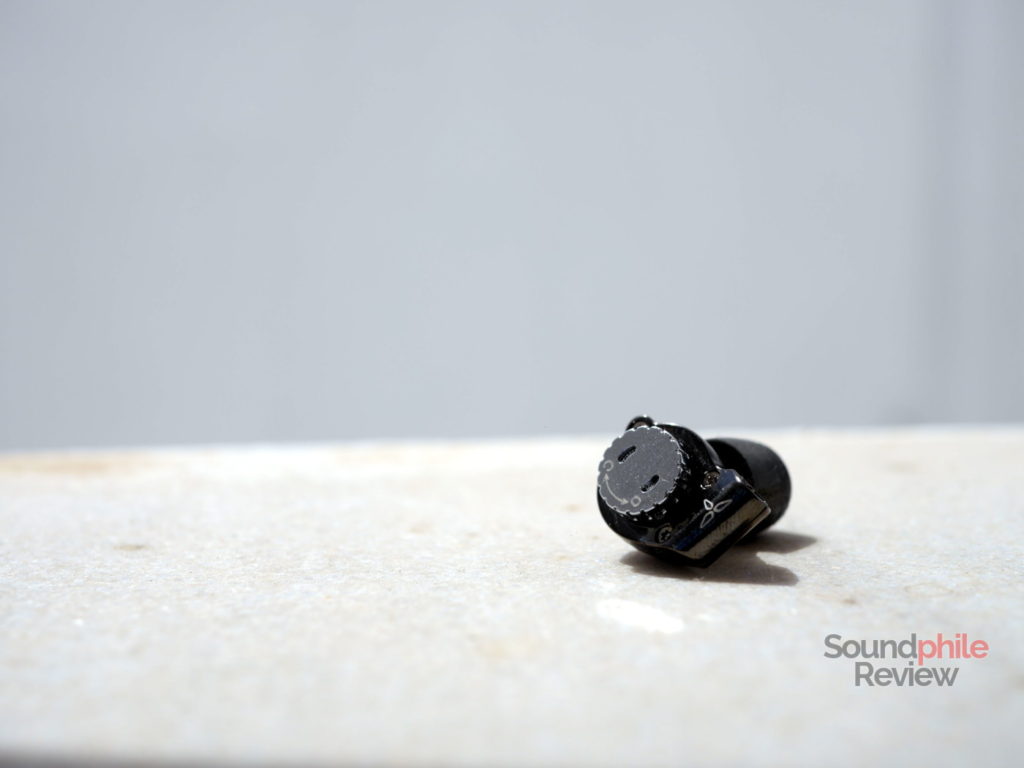
The earpieces are cast out of metal – aluminium, to be precise. The housings are precisely cast and assembled, with a high level of polish and attention to detail. Three screws hold it all together. The metal has a glossy finish that make it shiny and a fingerprint magnet – it gets “dirty” easily. Despite this, it looks really good and premium.
Like many other in-ear headphones, especially in the premium segment, the IMR Acoustics R1 have an over-the-ear cable design which makes it mandatory to have the cable running around your ear.
Build quality of the earpieces appears excellent: the housings are solid and display no play whatsoever in any of their components, so it looks they they were built with low tolerances and tight-fitting parts. That’s also true for the 2-pin connector receptacles, which allow for easy insertion and removal of the cable but keep a tight grip on it.
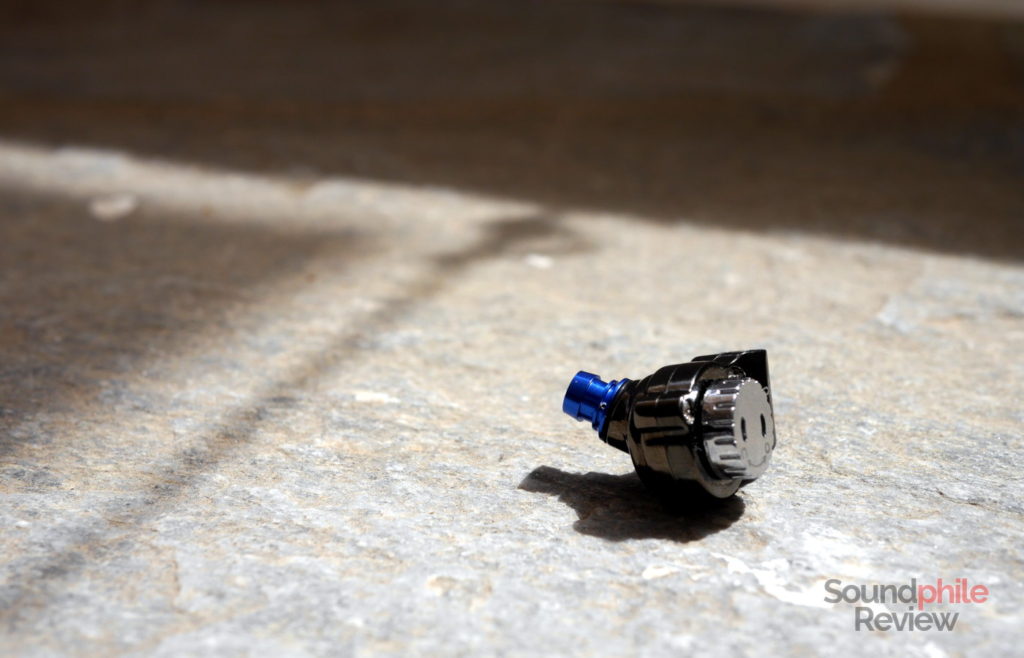
The IMR Acoustics R1 is characterised with the presence of a mechanism to alter the design from closed-back to open-back and viceversa and also with acoustic filters that make it possible to influence the tuning.
The open/close mechanism is neat and symmetrical: in both earpieces you need to rotate the gear towards the top (while you are wearing them: so clockwise on the right and counter-clockwise on the left) to make them open. This comes in especially handy as it makes it easy to remember how to switch configuration.
The acoustic filters are simply screwed on and unscrewed, so no complicated procedures are required to switch from one to another. It is rather easy and straightforward to switch filters, but fitting the screw can take a bit of time as the tolerances are pretty tight and getting the filter in the right position requires a bit of patience and precision.
Isolation is low whether you use the closed or open back, and regardless of the chosen eartips. I could distinctly hear my surroundings even in low-noise environments, and high-volume noise such as that on public transport was only attenuated a little bit, forcing me to raise the volume of music to hear anything. Sometimes (e.g. while on the subway) it was not worth raising the volume at all, as the noise was so loud it would have led me to dangerously high volume.
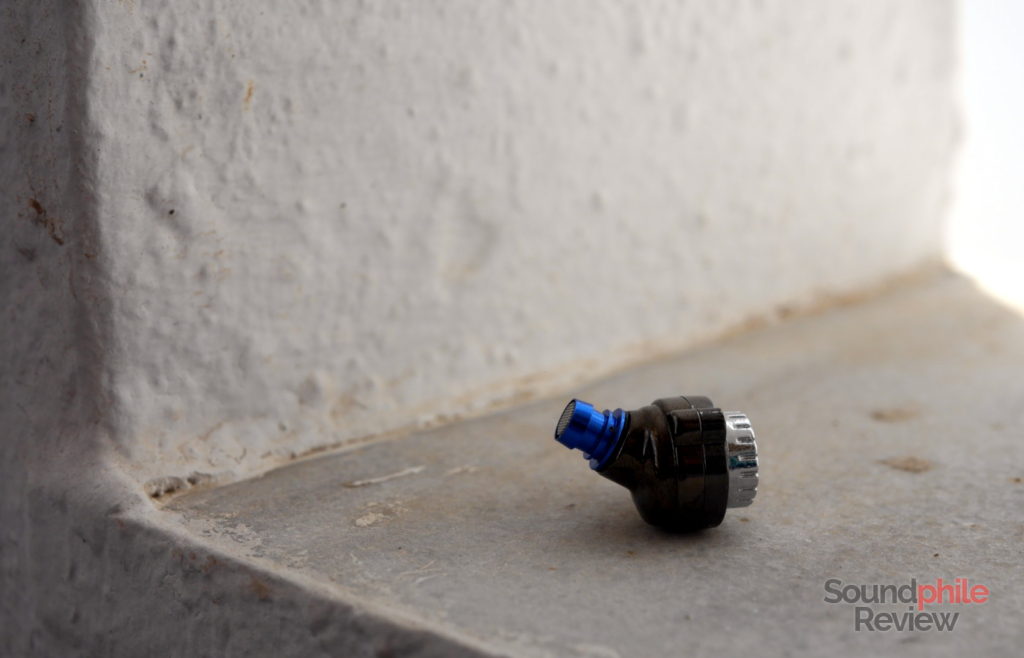
The peculiar shape of the housings results in a reduced level of comfort, at least to me: finding a comfortable position is difficult, as the live edges press against the pinna and soon require one to adjust the position to keep using the headphones. In all fairness, this discomfort usually arises after more than half an hour of usage and mainly on my right ear for reasons unknown. We’re still leagues apart from the RHA T20i or other similarly super-comfy headphones, and more in KZ ZS6‘s territory.
Despite having a 2-pin connector, finding a compatible cable for the IMR Acoustics R1 can prove challenging: they employ an odd configuration with the connector turned by 90°, a smaller plastic guide and a small plastic bit that sets the correct orientation, so most other cables (e.g. the AK Audio 7N copper cable or the Yinyoo 8-core SPC cable) can not be used with the R1.
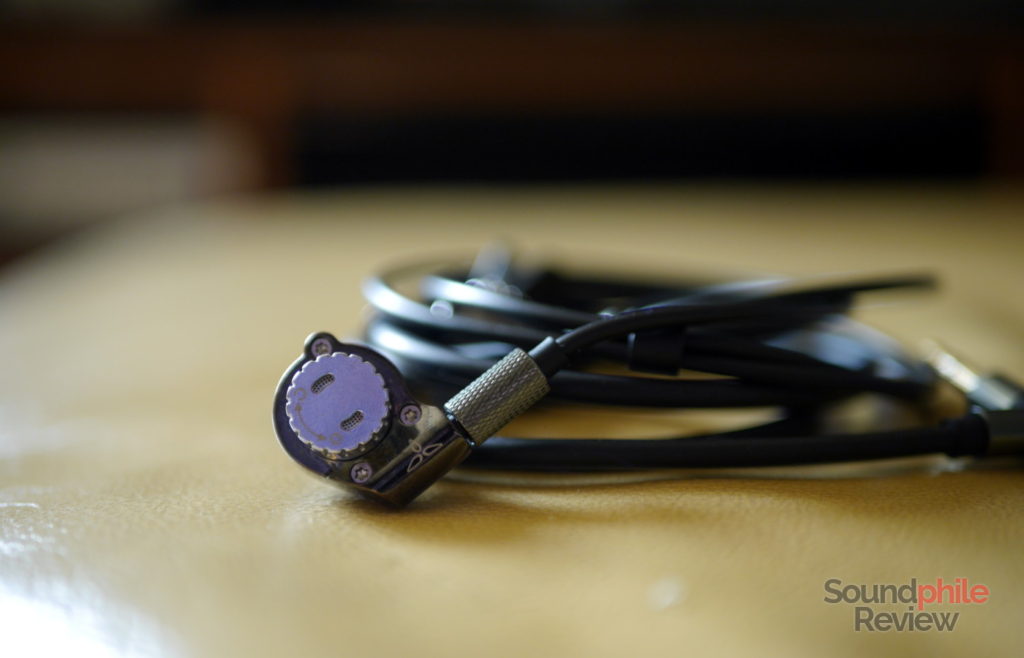
Due to the lack of an ear hook, two issues arise: comfort and microphonics. As the cable is free and it tends to keep its straight shape, it often escapes from its position around the ear and presses against the pinnae. It moves often and gives the wearer an impression of instability. On top of this, since it moves and there is no point where it is clamped down to reduce vibration, microphonics abound even when using the clip to secure it against the clothes. A partial solution is to use the chin slider to force the cable to stay in place.
In a classic, the devil is in the details. The IMR Acoustics R1 suffers from some minor flaws in a few areas, mainly related to the cable: the jack is not perfectly straight, the L junction on the jack housing and the strain relief on the jack housing is not aligned with the aluminium cylinder and there are a few leftover rubber pieces on cable junctions. Though really minimal, these flaws should not be there on a $500+ IEM – sound comes first, but looks also deserve attention.
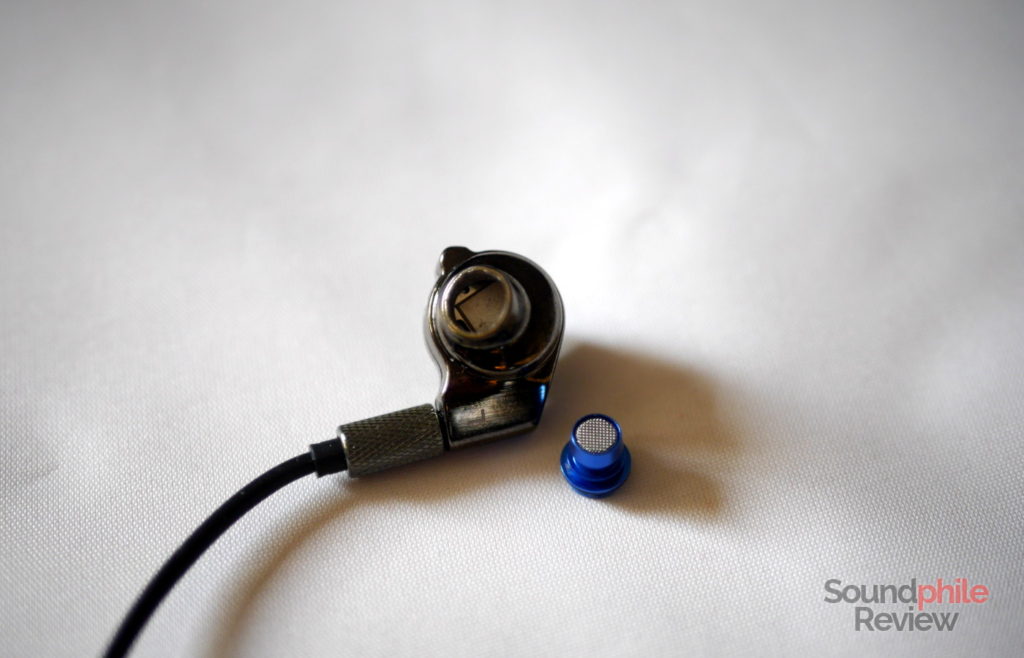
The single-flange silicone eartips allow for a good seal and isolation and are the best at both in my experience – which is, of course, strictly personal. They are quite similar to the eartips found in RHA headphones’ boxes, both in shape and consistency.
Foam eartips are quite stiff and difficult to compress; they also don’t stay compressed and are therefore harder to fit in the ear canal than other foam tips (e.g. Comply’s, which I have talked about in my best eartips article). They have a conical shape that closely resembles that of traditional silicone tips. I find them similar in comfort and isolation to the silicone tips, so I don’t see any real advantage to using them.
Dual flange tips, on the other side, are completely useless to me as they don’t seal my ear canals at all, thus making bass and lower mids disappear completely.
During my tests I ended up always using either the single-flange silicone tips or the Comply Isolation tips as they offered the best compromise between comfort, seal and isolation.
Sound & Specs
I used a few different sources when testing the IMR Acoustics R1: a Topping DX7, a Little Dot MKIII SE, an iFi micro iDSD Black Label, a RHA Dacamp L1, an iFi nano iDSD Black Label, a Head ‘n’ HiFi Objective2 fed by a Topping D30, a Topping NX4 DSD, an Aune M1s and a Cayin N5ii. I sometimes used an iFi IEMatch, too. 100 hours of break-in were applied, for what it’s worth. Source files are standard-res FLACs, mostly, with a few hi-res files and 320 kbps MP3s in-between.
IMR Acoustics R1 |
| Frequency response | 14 – 40,000 Hz |
| Impedance | 32 Ω |
| Sensitivity | 108 ± 3 dB |
The IMR Acoustics R1 uses two drivers: a dynamic driver which takes care of bass and mids, plus a ceramic plate driver that takes care of the highs. This configuration often leads to high impedance, but IMR Acoustics managed to keep it as low as 32 ohms.
Despite their impedance of 32 ohms and their sensitivity of 108 dB, the IMR Acoustics R1 surely like power. Amping them with a powerful device such as the iFi micro iDSD Black Label makes them really open up and sound wide and deep, showcasing all their gorgeous instrument separation. They surely take advantage of added power, but the IMR Acoustics R1 are also perfectly driven by sources with (relatively) limited power such as DAPs, portable amplifiers or even smartphones and PCs. When testing them, I used the Cayin N5ii and a few portable amplifiers, too, and I was satisfied with the result.
What really surprised me is the extent of the soundstage: it is huge and it sounds nothing like what an IEM usually does. It’s more akin to an open-back full-size headphone, though there are obvious differences in the sound presentation due to the different position and parts of the ear involved. You obviously are not going to hear music as you would using headphones such as the Sennheiser HD 650 or the AKG K712, but the R1 sound more similar to those than to e.g. the RHA T20i.
Instrument separation is so near to deserve being called “wonderful”. I still haven’t found a situation where the sound becomes confused and the instruments mix; on the contrary, it always sounds very clean and the instruments well-separated.
Speaking generally, the IMR Acoustics R1 has a balanced and decently neutral sound signature as it displays each part of the spectrum with more or less the same importance. There is no part that gets predominant or overcomes the rest; on the contrary, everything sounds level, with lower treble being just ever-so-slightly emphasised and adding a bit of sparkle to the sound.
As the IMR Acoustics R1 uses a system of filters to tune their sound to one’s liking (within relatively strict bounds), here’s a small analysis of how each filter sounds:
- Blue: the blue filter is the most accurate and balanced of the lot. It tames bass a bit and lets the mids shine while leaving the treble mostly untouched. The result is a balanced and mostly neutral sound signature that’s still very entertaining and fun to listen to. This is the filter I used as reference.
- Black: it is similar to the blue filter, but bass is more emphasised, thus leading to sound being warmer and even a bit darker. Despite this, lows are always well-controlled and never leak over the mids.
- Orange: mids are much more in the background, but so is bass and especially treble – the overall result is a warm, full-bodied sound signature with recessed highs.
- Pink: this filter makes the mids and especially the highs pop out, reducing lows and making therefore the sound brighter. The lows are still present and easy to hear, but they’re more in the background.
- Copper (which are more gold than copper): despite the description (“maximum bass, lush mids and slightly recessed highs”), the copper filters do not seem to reduce high that much – on the opposite, highs seem to be increased. Bass is actually increased, so the end result looks like a V-shaped sound signature to me. This may be the “funniest” filter of the lot.
The switch from closed to open back (and viceversa) brings about small changes in how the IMR Acoustics R1 sound: it is not a fundamental change, rather a matter of different shades of the same colour. The main impact it has is the change in the soundstage: it becomes much wider and deeper with the back open, also making instrument separation better. There’s also a small change in how bass is portrayed: while in the gear is in the “open” position, bass is actually more and a bit slower – which may come as a bit counter-intuitive.
Bass is deep and bold, yet not predominant. What really strikes me is the extension: despite the small driver size, the IMR Acoustics R1 reach 20 Hz with relative ease. This makes the sound full and complete, yet not warm or basshead territory. Control and accuracy are very good and produce a bass that is likeable and entertaining while also being faithful. It punches, and it punches hard, but it is always fast, impactful and never overstated. There’s a lot fine-texturing and small details that are portrayed by the R1, which goes to create a delightfully intricate and detailed bass region.
Midrange is rich and detailed, but most importantly it is incredibly clear: it really pops out and presents instruments in a way that makes them pleasant and easy to listen to. It is not completely neutral, as there is a bump around the ~2 kHz sector, right at the border with the lower treble. Despite the emphasis on the upper midrange, there is very low sibilance whether you’re listening to vocals or violins; the bright tone lends the sound energy and vitality but takes nothing away from it. It sounds really full of energy.
“Accuracy” is the first word that comes to my mind when speaking about the R1’s treble: there are lots of micro-details and its presentation makes music sound airy and spaced. Roll-off is subtle as there’s no real slope when going up in frequencies, it remains quite stable throughout the whole spectrum aside from the peak in the lower part where it joins the midrange. There is another smaller peak around the 10~11 kHz mark after which the treble starts rolling off, but it stays remarkably stable. There is a lot going on in the treble area and this contributes to the generally airy and vivacious sound of the R1; the details and separation really stand out and make listening to good recordings a pleasure.
You can listen to anything you want on the IMR Acoustics R1 – I find it pleasant to listen to Snarky Puppy, Emperor, Stevie Ray Vaughan, Röyksopp and Čaikovsky all the same. They are a bit of a Swiss army knife and the filters further expand their adaptability to different genres and styles.
I’m going to compare the IMR Acoustics R1 to a couple headphones:
- RHA CL1 Ceramic: when they launched, the price of the CL1 was near that of the R1; on top of this, they feature a detachable cable (though using a proprietary derivative of the MMCX standard). Soundwise, the CL1 are heavily tilted towards highs and have a piercing and extremely forward treble section, accompanied by powerful bass, recessed lower mids and emphasised upper mids. When it comes to balance, coherence, naturalness and pleasantness, the R1 wins hands down – they are just better, because their tuning is more neutral. Instrument separation and detail retrieval on the CL1 Ceramic are very close to the R1, and soundstage is not that distant, so in terms of technicalities the two are not too far from each other (though the R1 wins).
- RHA T20i: the T20i are much more balanced than the CL1, though they still put mid-bass forward and also emphasise treble (using the treble filter, which does not alter sound produced by the drivers). The R1 offer more presence in the sub-bass region, better instrument separation and larger soundstage, though the overall instrument presence seems to be better on the T20i – due to their tuning, it appears like instruments are more vivid and “in your face”. This can be either good or bad, depending on your personal preference.
Final Thoughts
In the audio world, most things are subjective – the very perception of sound is itself something personal as each one of us hears differently. Even preferences for sound signatures of equipment are personal and this is the reason so many different signatures exist – each has their bias and tunes their preferences according to that. My own personal, strictly subjective point of view on the IMR Acoustics R1 is that I totally love how it sounds.
Now, this review wouldn’t be that reliable if I was just writing my own “acoustically-biased” opinion on a product. So my unbiased opinion on the IMR Acoustics R1 is that it does a great job at targeting a neutral frequency response, but it misses it by a thread. Its emphasis on higher mids makes all the difference as the sound is a tad bright and sparkling. On top of this, bass also has a very slight elevation, so it appears a bit bold. All in all the signature is balanced and likeable; some may say it is more musical than analytical, but I think it is a good compromise between the two approaches.
The £500 (~€580, ~$630) price is certainly a factor that can’t be ignored. It places the IMR Acoustics R1 in the midrange, where it is caught in crossfire from both cheaper products and top-of-the-line offerings. Despite this, it is capable of holding its own against both, thanks to its acoustic abilities and features. Maybe it is not as refined as flagship offerings that have twice the price, but it sounds darn good.

